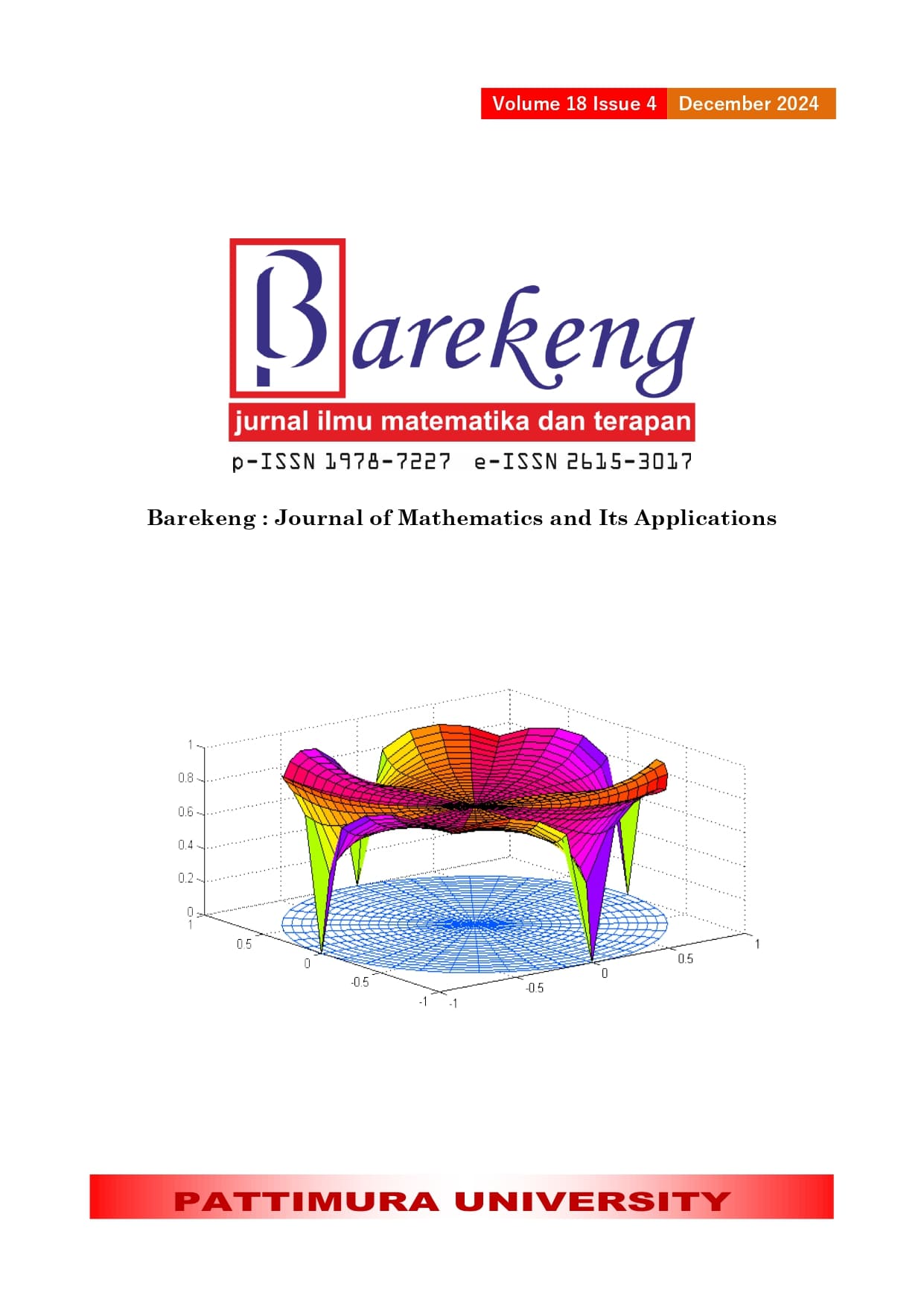PYTHON IN ORDINARY DIFFERENTIAL EQUATIONS LEARNING
Abstract
Using software in mathematics learning can improve students' soft and hard mathematics skills at the high school and college levels. Therefore, using software in the learning process is important, including in learning Differential Equations. This research examines the use of the Python programming language with Jupyter Lab software and the SymPy library in solving ordinary differential equation problems symbolically in the Differential Equations course. The use of the Python programming language in Differential Equations learning includes solving linear ordinary differential equations of first-order, second-order, higher-order, and the Laplace transform. This research also examines the effect of using Python on the learning outcomes of differential equations of Mathematics Education Study Program students, Study Program Outside the Main Campus, Pattimura University. The population in this quantitative research is all students who programmed differential equations courses in the even semester of the 2023-2024 academic year as many as 19 students. The Python programming language can be used to solve differential equation problems symbolically easily, quickly, and accurately. In addition, using Jupyter Lab makes the process of solving differential equation problems easier and more interactive. Furthermore, t-test results show that the use of Python in learning differential equations can improve students' learning activities and learning outcomes. Using the Python programming language with Jupyter Lab software and the SymPy library can be developed to create teaching materials, textbooks, and reference books for Differential Equations courses.
Downloads
References
R. Kurniati and R. A. Ramly, “Development of Macromedia Flash Module in the Learning Media Course Faculty of Teacher Training and Education University of Pejuang Republik Indonesia,” MaPan J. Mat. dan Pembelajaran, vol. 10, no. 2, pp. 366–384, 2022.
R. Kurniati, S. Sugiarto, and Lestari, “Systematic Literature Review (Slr) of Technology in Mathematics Learning During the Last Decade,” MaPan J. Mat. dan Pembelajaran, vol. 11, no. 2, pp. 386–402, 2023, doi: 10.24252/10.24252/mapan.2023v11n2a12.
D. Hewitt, “Designing Educational Software: The Case of Grid Algebra,” Digit. Exp. Math. Educ., vol. 2, no. 2, pp. 167–198, 2016, doi: 10.1007/s40751-016-0018-4.
N. Panorkou and D. Pratt, “Using Google SketchUp to Develop Students’ Experiences of Dimension in Geometry,” Digit. Exp. Math. Educ., vol. 2, no. 3, pp. 199–227, 2016, doi: 10.1007/s40751-016-0021-9.
G. Roorda, P. Vos, P. Drijvers, and M. Goedhart, “Solving Rate of Change Tasks with a Graphing Calculator: a Case Study on Instrumental Genesis,” Digit. Exp. Math. Educ., vol. 2, no. 3, pp. 228–252, 2016, doi: 10.1007/s40751-016-0022-8.
W. Xu and F. Ouyang, “The application of AI technologies in STEM education: a systematic review from 2011 to 2021,” Int. J. STEM Educ., vol. 9, no. 1, 2022, doi: 10.1186/s40594-022-00377-5.
Lestari, S. Sugiarto, and R. Kurniati, “Systematic Literature Review (Slr): Pemanfaatan Software Geogebra Dalam Pembelajaran Matematika,” J. Rev. Pendidik. dan Pengajaran, vol. 6, no. 4, pp. 3275–3287, 2023, [Online]. Available: http://journal.universitaspahlawan.ac.id/index.php/jrpp/article/view/22627
H. Amin, Zahedi, L. Enos, A. Ansoruddin, W. Wingkolain, and E. Efendi, “C PROGRAM AS A TOOL FOR THE TEACHING OF SECOND ORDER ORDINARY DIFFERENTIAL EQUATION,” BAREKENG J. Math. Its Appl., vol. 18, no. 1, pp. 205–212, 2024.
Badan Pusat Statistik Kabupaten Maluku Barat Daya, “Statistik Daerah Kabupaten Maluku Barat Daya,” Tiakur, 2023.
S. Sugiarto, Metode Numerik dengan Scilab dan Python. Bandung: Alfabeta, 2023.
J. Sundnes, Solving Ordinary Differential Equations in Python. Oslo: Simula SpringerBriefs on Computing, 2024.
W. McKinney, Python for Data Analysis, Second Edi. Sebastopol: O’Reilly Media Inc, 2018.
P. Bruce, A. Bruce, and P. Gedeck, Practical Statistics for Data Scientists, Second Edi. Sebastopol: O’Reilly Media Inc, 2020.
J. Grus, Data Science from Scratch, Second Edi. Sebastopol: O’Reilly Media Inc, 2019.
A. A. Aldino and M. Ulfa, “OPTIMIZATION OF LAMPUNG BATIK PRODUCTION USING THE SIMPLEX METHOD,” BAREKENG J. Ilmu Mat. dan Terap., vol. 15, no. 2, pp. 297–304, 2021.
S. Sugiarto, Pemodelan Matematika Penyebaran Penyakit Tuberkulosis. Nganjuk: Dewa Publishing, 2024.
T. Chao, J. Chen, J. R. Star, and C. Dede, “Using Digital Resources for Motivation and Engagement in Learning Mathematics: Reflections from Teachers and Students,” Digit. Exp. Math. Educ., vol. 2, no. 3, pp. 253–277, 2016, doi: 10.1007/s40751-016-0024-6.
M. Teplá, P. Teplý, and P. Šmejkal, “Influence of 3D models and animations on students in natural subjects,” Int. J. STEM Educ., vol. 9, no. 1, 2022, doi: 10.1186/s40594-022-00382-8.
A. Sokolowski, Y. Li, and V. Willson, “The effects of using exploratory computerized environments in grades 1 to 8 mathematics: a meta-analysis of research,” Int. J. STEM Educ., vol. 2, no. 1, 2015, doi: 10.1186/s40594-015-0022-z.
B. Tamam and D. Dasari, “The use of Geogebra software in teaching mathematics The use of Geogebra software in teaching mathematics,” J. Phys. Conf. Ser., vol. 1882, no. 012042, pp. 1–6, 2021, doi: 10.1088/1742-6596/1882/1/012042.
Copyright (c) 2024 Sigit Sugiarto, Ratnah Kurniati MA, John Nandito Lekitoo

This work is licensed under a Creative Commons Attribution-ShareAlike 4.0 International License.
Authors who publish with this Journal agree to the following terms:
- Author retain copyright and grant the journal right of first publication with the work simultaneously licensed under a creative commons attribution license that allow others to share the work within an acknowledgement of the work’s authorship and initial publication of this journal.
- Authors are able to enter into separate, additional contractual arrangement for the non-exclusive distribution of the journal’s published version of the work (e.g. acknowledgement of its initial publication in this journal).
- Authors are permitted and encouraged to post their work online (e.g. in institutional repositories or on their websites) prior to and during the submission process, as it can lead to productive exchanges, as well as earlier and greater citation of published works.






1.gif)



